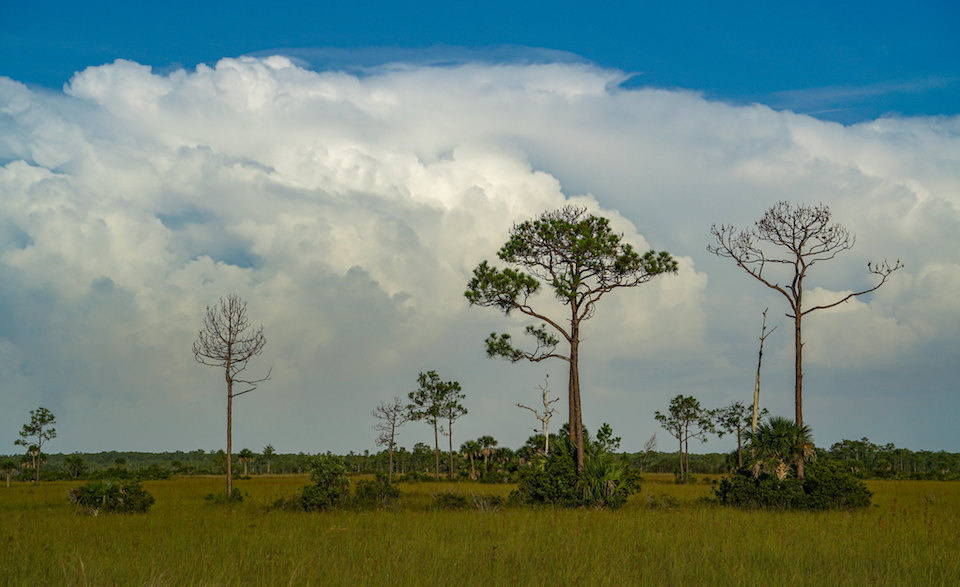- Terrestrial Ecosystems
Climate Impacts on Florida's Terrestrial Ecosystems

Impacts of Sea Level Rise:
- Loss of beach and dune habitat where there are barriers to inland migration
- Loss of beach and dune habitat due to increased erosion
- Habitat fragmentation
- Shifts in composition of coastal upland forest habitats as species more tolerant to frequent inundation become more dominant
- Habitat fragmentation
- Loss of most pine rockland communities
- Loss of critical upland forest habitat in the Florida keys
Impacts of Salinity Shifts:
- Loss of coastal upland forest habitat as they transition into other more salt tolerant systems due to increased groundwater and soil salinity
- Alteration in type, abundance and configuration of coastal upland communities as increased groundwater and soil salinity increases cause changes in plant communities (shifts to more salt tolerant species) leading to habitat loss and fragmentation
- Decreased fire frequency/intensity due to loss of fuel (pines, other vegetation) as salinity stress from salinization of groundwater and increased tidal overwash causes reduction in fuel species
- Decoupling of mutualistic relationships as salt-intolerant plants and animals are reduced and/or replaced by salt tolerant species
- Loss of critical upland forest habitat in the Florida Keys
- Reduction/loss of critical freshwater sources in the Florida Keys
Impacts of Warmer Summer Temperatures:
- More frequent and/or more intense wildfire
- Plants species range reductions or shifts
- Reduction of rare communities due to temperature increases exacerbating existing stressors
- Increased competitive pressure on native vegetation as density and distribution increases for other native, more heat-tolerant species
Impacts of Warmer Winter Temperatures:
- Reduced fitness, regeneration, and competitive ability due to increased exposure to new pathogens or parasites as diseases/disease vectors respond to warmer temperatures
- Increased mortality of plants due to increased pathogen survival and disease transmission rates
- Pine forests shifting to pine-oak forests
- Northward shift of subtropical and temperate communities
Impacts of Increased Extreme Heat Events:
- Increased heat stress on plants
- Increased soil temperature and associated changes to soil chemistry and root dynamics
- Increased mortality of plants due to heat intolerance
- Range expansion of native and exotic plant species
- Increased abundance and prevalence of invasive species
- Altered species composition
- Altered community structure
- Altered fire regime
- More frequent and/or more intense wildfires
- Increased impact from pests due to heat stress
Impacts of Increased Extreme Cold Events:
- Reduced reproductive/regeneration success due to delayed or interrupted reproduction
- Delayed plant flowering leading to weakening/breaking of linkages between species
- Shift in species distribution due to temperature extremes and interactions of temperature, precipitation and possibly CO2
- Increased die-offs of plants due to extreme cold events
- Limit northern extent/expansion of exotic species range (potential beneficial change)
Impacts of Increased Precipitation:
- Increased above ground biomass (particularly in scrub ecosystems)
- Loss of suitable ground-nesting habitat due to seasonal flooding
- Reduced efficiency of prescribed due to increased soil moisture and increased plant growth
- Increased erosion
- Altered community composition
Impacts of Decreased Precipitation:
- Increased wildfires due to drier conditions
- Increased competitive pressure on native vegetation as density and distribution increases for other native, more drought-tolerant species
- Altered community composition
- Reduced fitness due to stress
- Shifts in range of temperate trees and shrubs as rainfall decreases and temperature increases
- Range expansion of sub-tropical vegetation and range contraction of temperate woody species
- Southern pine forests replaced by pine savannas and grassland due to increased fires and stress
- Decreased efficiency of prescribed fire as opportunities to burn are reduced
- Increased pine mortality due to pine beetle infestations as trees become stressed
Impacts of Changes in Timing of Precipitation:
- Reduced reproductive success – decreased bloom/fruit/seed production
- Reduced growth/reduced growing season
- Altered grassland plant species composition due to increased rainfall variability
Impacts of Changes in Frequency and Severity of Extreme Events:
- Altered habitat type/composition of forested riparian communities due wind damage
- Increased mortality
- Reduced fitness of species
- Increased exposure to invasive species and parasites
- Disruption of life cycle events
- Increased accumulation of heavy metals and other pollution
- Wind damage – loss of habitat
Impacts from Increased Floods:
- Increased tree/plant mortality due to higher water levels
- Shift in dominant tree/plant species due to species-specific flood induced mortality
Impacts from Increased Droughts:
- Changes in community composition
- Increased prevalence of invasive species
- Increase in wildfires
- Reduced opportunities for prescribed fire
- Increased pest outbreaks
- Loss of ephemeral ponds and wetlands
- Increased drought related diseases in forest trees
What's next?
Learn about interactions between climate change and existing stressors to habitats in Florida.